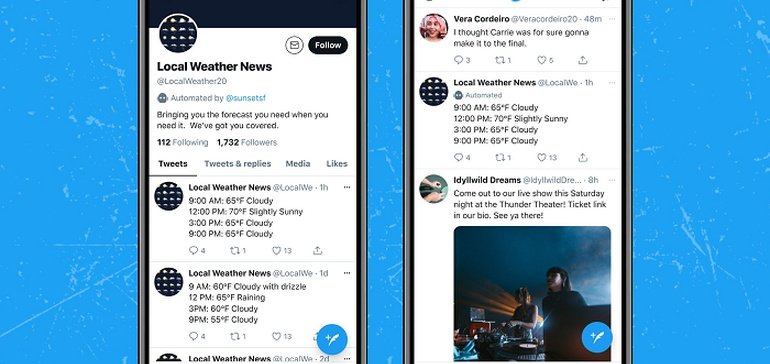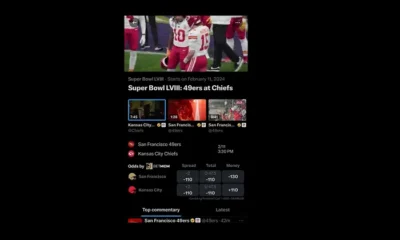SOCIAL
Twitter Launches New Bot Labels to Identify Bot Accounts In-Stream

Twitter is taking the next step in adding more transparency to the tweet process by rolling out its new bot labels, which developers will now be able to voluntarily add to automated accounts.
As you can see in this example, now, bot accounts on Twitter will be displayed with a new robot icon next to the profile name, and a marker denoting that the account is automated.
The same will also be displayed in the tweet feed, with an ‘Automated’ tag beneath the profile name on tweets.
Twitter’s using the voluntary labels as a means to help highlight ‘Good Bots’, as opposed to bot accounts that are used for negative purpose.
As explained by Twitter:
“#GoodBots help people stay apprised of useful, entertaining, and relevant information from fun emoji mashups to breaking news. The label will give people on Twitter additional information about the bot and its purpose to help them decide which accounts to follow, engage with, and trust.”
So it’s not designed to be an all-encompassing, bot vs human-controlled identifier at this stage. But it’s a step in that direction – and with bots long being identified as a key problem on the platform, it could, eventually, be a key element in combating misuse.
Twitter’s been developing the new bot identifier for some time, and launched a live test of the option back in September. Twitter also rolled out an update for developers back in 2020 which made the identification of bot accounts a requirement of using its platform. That, essentially, means that operating a bot account without declaring that it’s a bot is against Twitter’s rules, which gives the platform more direct means to remove accounts which don’t disclose such.
The new bot labels are the next step, which, at least in theory, should mean that all legitimate bot accounts on the platform will now be labeled as such, which will make it easier for users to understand who and what they’re engaging with, and could have a big impact on content distribution and amplification.
Maybe.
While Twitter is implementing new rules around bot usage, that doesn’t mean that those seeking to use bots for negative purpose will adhere to such.
As noted, Twitter bots have repeatedly been identified as a key distributor of misinformation and/or divisive messaging, with people using bots to influence tweet trends and make movements appear more popular than they are.
In the wake of the 2016 US Election, for example, researchers uncovered “huge, inter-connected Twitter bot networks” which had been used to influence political discussion, the largest of which incorporating some 500,000 fake accounts. In 2018, Wired reported that bot profiles often dominated political news streams, with bots contributing up to 60% of tweet activity around some events.
Even more recently, reports have suggested that the Chinese Government has been using social media bots to ‘advance an authoritarian agenda’ via global trends.
These types of operators are not likely to voluntarily disclose themselves via these new labels, so while Twitter’s new bot tags are a good thing for general transparency, they won’t necessarily stop the misuse of bots for such actions.
But maybe, as noted, they’re another step in the right direction, and in combination with more specific rules on the use of bots, and improved detection processes, Twitter’s now taking more direct steps in addressing its bot problem, and helping users avoid potential manipulation.
It can only help – Twitter’s new bot labels are being rolled out to all self-reported bot accounts from today.
SOCIAL
Snapchat Explores New Messaging Retention Feature: A Game-Changer or Risky Move?

In a recent announcement, Snapchat revealed a groundbreaking update that challenges its traditional design ethos. The platform is experimenting with an option that allows users to defy the 24-hour auto-delete rule, a feature synonymous with Snapchat’s ephemeral messaging model.
The proposed change aims to introduce a “Never delete” option in messaging retention settings, aligning Snapchat more closely with conventional messaging apps. While this move may blur Snapchat’s distinctive selling point, Snap appears convinced of its necessity.
According to Snap, the decision stems from user feedback and a commitment to innovation based on user needs. The company aims to provide greater flexibility and control over conversations, catering to the preferences of its community.
Currently undergoing trials in select markets, the new feature empowers users to adjust retention settings on a conversation-by-conversation basis. Flexibility remains paramount, with participants able to modify settings within chats and receive in-chat notifications to ensure transparency.
Snapchat underscores that the default auto-delete feature will persist, reinforcing its design philosophy centered on ephemerality. However, with the app gaining traction as a primary messaging platform, the option offers users a means to preserve longer chat histories.
The update marks a pivotal moment for Snapchat, renowned for its disappearing message premise, especially popular among younger demographics. Retaining this focus has been pivotal to Snapchat’s identity, but the shift suggests a broader strategy aimed at diversifying its user base.
This strategy may appeal particularly to older demographics, potentially extending Snapchat’s relevance as users age. By emulating features of conventional messaging platforms, Snapchat seeks to enhance its appeal and broaden its reach.
Yet, the introduction of message retention poses questions about Snapchat’s uniqueness. While addressing user demands, the risk of diluting Snapchat’s distinctiveness looms large.
As Snapchat ventures into uncharted territory, the outcome of this experiment remains uncertain. Will message retention propel Snapchat to new heights, or will it compromise the platform’s uniqueness?
Only time will tell.
SOCIAL
Catering to specific audience boosts your business, says accountant turned coach

While it is tempting to try to appeal to a broad audience, the founder of alcohol-free coaching service Just the Tonic, Sandra Parker, believes the best thing you can do for your business is focus on your niche. Here’s how she did just that.
When running a business, reaching out to as many clients as possible can be tempting. But it also risks making your marketing “too generic,” warns Sandra Parker, the founder of Just The Tonic Coaching.
“From the very start of my business, I knew exactly who I could help and who I couldn’t,” Parker told My Biggest Lessons.
Parker struggled with alcohol dependence as a young professional. Today, her business targets high-achieving individuals who face challenges similar to those she had early in her career.
“I understand their frustrations, I understand their fears, and I understand their coping mechanisms and the stories they’re telling themselves,” Parker said. “Because of that, I’m able to market very effectively, to speak in a language that they understand, and am able to reach them.”Â
“I believe that it’s really important that you know exactly who your customer or your client is, and you target them, and you resist the temptation to make your marketing too generic to try and reach everyone,” she explained.
“If you speak specifically to your target clients, you will reach them, and I believe that’s the way that you’re going to be more successful.
Watch the video for more of Sandra Parker’s biggest lessons.
SOCIAL
Instagram Tests Live-Stream Games to Enhance Engagement

Instagram’s testing out some new options to help spice up your live-streams in the app, with some live broadcasters now able to select a game that they can play with viewers in-stream.
As you can see in these example screens, posted by Ahmed Ghanem, some creators now have the option to play either “This or That”, a question and answer prompt that you can share with your viewers, or “Trivia”, to generate more engagement within your IG live-streams.
That could be a simple way to spark more conversation and interaction, which could then lead into further engagement opportunities from your live audience.
Meta’s been exploring more ways to make live-streaming a bigger consideration for IG creators, with a view to live-streams potentially catching on with more users.
That includes the gradual expansion of its “Stars” live-stream donation program, giving more creators in more regions a means to accept donations from live-stream viewers, while back in December, Instagram also added some new options to make it easier to go live using third-party tools via desktop PCs.
Live streaming has been a major shift in China, where shopping live-streams, in particular, have led to massive opportunities for streaming platforms. They haven’t caught on in the same way in Western regions, but as TikTok and YouTube look to push live-stream adoption, there is still a chance that they will become a much bigger element in future.
Which is why IG is also trying to stay in touch, and add more ways for its creators to engage via streams. Live-stream games is another element within this, which could make this a better community-building, and potentially sales-driving option.
We’ve asked Instagram for more information on this test, and we’ll update this post if/when we hear back.
-

 PPC4 days ago
PPC4 days ago19 Best SEO Tools in 2024 (For Every Use Case)
-
SEARCHENGINES7 days ago
Daily Search Forum Recap: April 16, 2024
-

 SEO7 days ago
SEO7 days agoGoogle Clarifies Vacation Rental Structured Data
-

 MARKETING6 days ago
MARKETING6 days agoStreamlining Processes for Increased Efficiency and Results
-
SEARCHENGINES6 days ago
Daily Search Forum Recap: April 17, 2024
-

 SEO6 days ago
SEO6 days agoAn In-Depth Guide And Best Practices For Mobile SEO
-

 PPC6 days ago
PPC6 days ago97 Marvelous May Content Ideas for Blog Posts, Videos, & More
-
SEARCHENGINES5 days ago
Daily Search Forum Recap: April 18, 2024















You must be logged in to post a comment Login